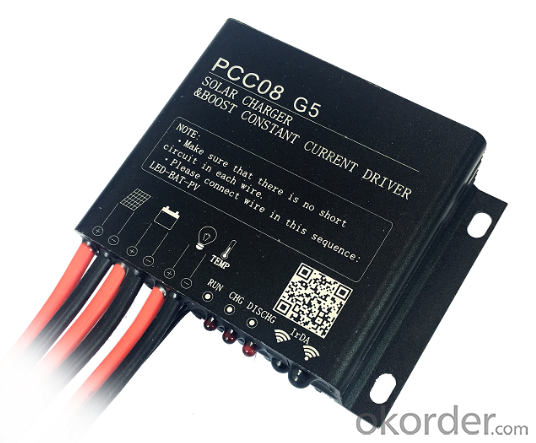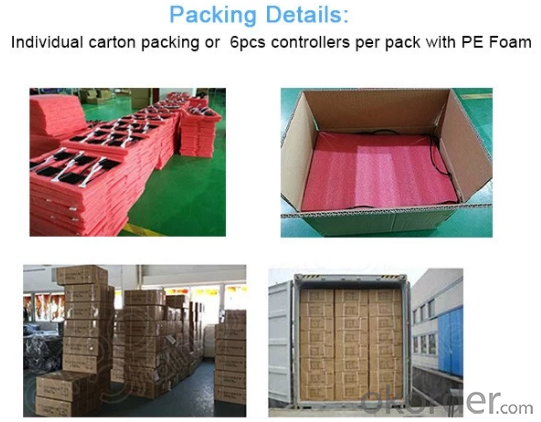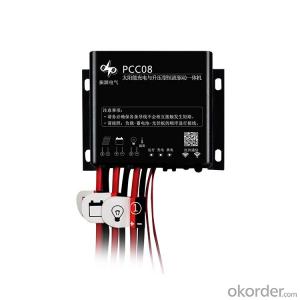IP68 PCC08 8a 12V PWM Solar Charger Controller for Solar Street light
- Loading Port:
- China main port
- Payment Terms:
- TT OR LC
- Min Order Qty:
- 1 pc
- Supply Capability:
- 1000 pc/month
OKorder Service Pledge
OKorder Financial Service
You Might Also Like
1.Features :
*Professional design to promote system reliability
-Using international well-know brand semiconductor device.
- High LED driving, significantly reduce the product temperature.
- IP68 protection degree without any buttons, further improve the waterproof reliability.
*Discharge efficiency
- LED constant current drive efficiency up to 96%
-Dimming LED constant current drive efficiency from 91%-96%
*Minimal power consumption
-The current consumption ≤10mA
*Intelligent battery management
-It is PWM and CV charge, which matches with Li protect board perfectly.
- Significantly extends the battery lifetime up to 50% base on intelligent temperature
compensation charge and discharge management.
- Intelligent energy management of battery ensures that the battery charge & discharge in
shallow state which significantly extend the battery life.
*Intelligent LED drive management
- Light control function, automatic lights LED in the dark, turn off automatically at dawn
- Constant current drive
- three times control.
- Delaying infrared body sensor
- Morning lighting
- Dimming function, control to output different power in different typical time.
*Flexible parameter set
- Excellent man-machine interface, convenient operation.
- Infrared wireless communications, connecting with a handheld remote control for easy installation.
*Protect function
- Battery and the solar panel reverse connection protection.
- To prevent the battery discharge to the solar panel .
- Battery low voltage disconnect and reconnect voltage protection.
-The LED output short and open circuit protection.
2. Technical parameter
Model | PCC08 G4 |
System voltage | 12V |
Output power | 40W/12 V |
Static power consumption | 13 mA/12 V |
Rated charging current | 8 A |
Solar panel power | ≤ 120 W |
Solar panel open-circuit voltage | < 25 V |
MPPT tracking efficiency | 96% |
Typical constant current source efficiency | 90% to 96% |
Overvoltage protection | Overcharge voltage 2 V |
Charging voltage limit | Overcharge voltage 1 V |
Current accuracy | ±3% |
Over-temperature protection | 85 °C |
Light control voltage | 16 V ~50 V |
Operating temperature | -35 °C ~+60 °C |
Protection degree | IP68 |
Weight | 180g |
Dimensions (mm) | 58*82*23.5 |
3. Images


4.FAQ
Q: DO YOU HAVE ANY CERTIFICATION FOR YOUR PRODUCTS?
A: We have ISO9001:2015, CE、 RoHS certifications for all of our products.
Q: DO YOU HAVE MOQ FOR PLACE ORDER?
A: Low MOQ, 1pe for sample checking is available.
- Q:How do I choose the right solar controller for my system?
- Choosing the right solar controller for your system involves considering factors such as the type of solar panels, battery capacity, system voltage, and specific requirements like temperature compensation or programmable settings. It is important to match the controller's capabilities with the specific needs of your solar system to ensure optimal performance and longevity. Consulting with a solar professional or doing thorough research can help you make an informed decision.
- Q:Can a solar controller be used with solar panel tilt and azimuth adjustment systems?
- Yes, a solar controller can be used with solar panel tilt and azimuth adjustment systems. A solar controller is typically used to regulate the charging of batteries connected to solar panels. It monitors the voltage and current coming from the solar panels and ensures that the batteries are charged efficiently and safely. When it comes to solar panel tilt and azimuth adjustment systems, they are used to optimize the positioning of solar panels for maximum sunlight exposure. Tilt adjustment allows the panels to be angled towards the sun at different times of the year, while azimuth adjustment allows for orienting the panels towards the sun's position throughout the day. In the context of using a solar controller with these adjustment systems, the controller would still perform its primary function of regulating the charging process. However, it would need to be integrated with the tilt and azimuth adjustment systems to ensure proper functioning. The solar controller would need to receive input from sensors or devices that determine the optimal tilt and azimuth angles for the solar panels based on factors like time of year and the sun's position. This information would then be used by the controller to adjust the charging parameters accordingly. By integrating a solar controller with tilt and azimuth adjustment systems, it becomes possible to not only optimize the charging process but also maximize the overall energy generation of the solar panels. This can result in increased efficiency and improved performance of the solar power system.
- Q:How does a solar controller handle temperature compensation for batteries?
- A solar controller handles temperature compensation for batteries by adjusting the charging voltage based on the temperature of the batteries. This helps optimize the charging process and prevent overcharging or undercharging of the batteries, ensuring their longevity and performance.
- Q:Can a solar controller be used with solar-powered indoor recreational facilities?
- Yes, a solar controller can be used with solar-powered indoor recreational facilities. A solar controller is a crucial component of a solar power system that helps regulate the flow of electricity from the solar panels to the batteries. It ensures that the batteries are charged efficiently and prevents overcharging or damage to the batteries. In the case of solar-powered indoor recreational facilities, such as indoor swimming pools, gyms, or entertainment centers, a solar controller can be used to manage the energy produced by the solar panels. It helps optimize the energy usage, store excess energy in batteries, and ensure a continuous power supply even during periods of low or no sunlight. By using a solar controller, indoor recreational facilities can significantly reduce their reliance on traditional grid electricity, lower their energy costs, and promote sustainability. Additionally, it allows these facilities to operate independently of the grid, making them more resilient to power outages or disruptions. Overall, incorporating a solar controller into a solar-powered indoor recreational facility is a smart and sustainable choice that can lead to long-term cost savings and environmental benefits.
- Q:Can a solar controller be used with solar panels of different weights?
- Yes, a solar controller can be used with solar panels of different weights. The purpose of a solar controller is to regulate the flow of electricity from the solar panels to the battery or load. It does not depend on the weight of the solar panels. The main factors to consider when using a solar controller are the voltage and current ratings of the panels, which should be within the specifications of the controller. As long as the voltage and current ratings are compatible, the solar controller can be used with solar panels of different weights.
- Q:What is the maximum charging efficiency for a solar controller?
- The maximum charging efficiency for a solar controller is typically around 98%.
- Q:Can a solar controller be used with solar panels of different manufacturers?
- Yes, a solar controller can be used with solar panels of different manufacturers as long as they have compatible specifications and voltage ratings. However, it is important to ensure that the controller is able to handle the combined power output of the panels and adjust its settings accordingly.
- Q:Can a solar controller handle high temperatures?
- Yes, a solar controller can handle high temperatures. Solar controllers are designed to operate efficiently even in extreme heat conditions, ensuring the proper functioning and protection of the connected solar panels and batteries. They are equipped with thermal management systems and components that can withstand high temperatures without compromising their performance or longevity.
- Q:What is the maximum load current in standby mode of a solar controller?
- The maximum load current in standby mode of a solar controller typically depends on the specific model and its design specifications. However, the load current in standby mode is usually very minimal, often around a few milliamperes or even less. This low current ensures that the solar controller consumes minimal power while in standby, maximizing energy efficiency.
- Q:How do I clean and maintain a solar controller?
- To clean and maintain a solar controller, follow these simple steps: 1. Switch off the solar controller and disconnect it from the power source. 2. Use a clean, dry cloth or a soft brush to gently remove any dust or debris from the surface of the controller. 3. If there are stubborn stains or dirt, dampen the cloth with a mild soapy water solution and carefully wipe the controller. Avoid using harsh chemicals or abrasive materials that may damage the surface. 4. Pay attention to the vents or cooling fans, and use a can of compressed air or a soft brush to remove any dust or dirt that may have accumulated there. 5. Inspect the wiring connections to ensure they are secure and free from any corrosion. If you notice any loose or damaged wires, consult a professional for repairs. 6. Finally, re-connect the solar controller to the power source and switch it on. Monitor its performance regularly to identify any issues that may require further maintenance or professional assistance.
1. Manufacturer Overview |
|
|---|---|
| Location | |
| Year Established | |
| Annual Output Value | |
| Main Markets | |
| Company Certifications | |
2. Manufacturer Certificates |
|
|---|---|
| a) Certification Name | |
| Range | |
| Reference | |
| Validity Period | |
3. Manufacturer Capability |
|
|---|---|
| a)Trade Capacity | |
| Nearest Port | |
| Export Percentage | |
| No.of Employees in Trade Department | |
| Language Spoken: | |
| b)Factory Information | |
| Factory Size: | |
| No. of Production Lines | |
| Contract Manufacturing | |
| Product Price Range | |
Send your message to us
IP68 PCC08 8a 12V PWM Solar Charger Controller for Solar Street light
- Loading Port:
- China main port
- Payment Terms:
- TT OR LC
- Min Order Qty:
- 1 pc
- Supply Capability:
- 1000 pc/month
OKorder Service Pledge
OKorder Financial Service
Similar products
New products
Hot products
Related keywords






























